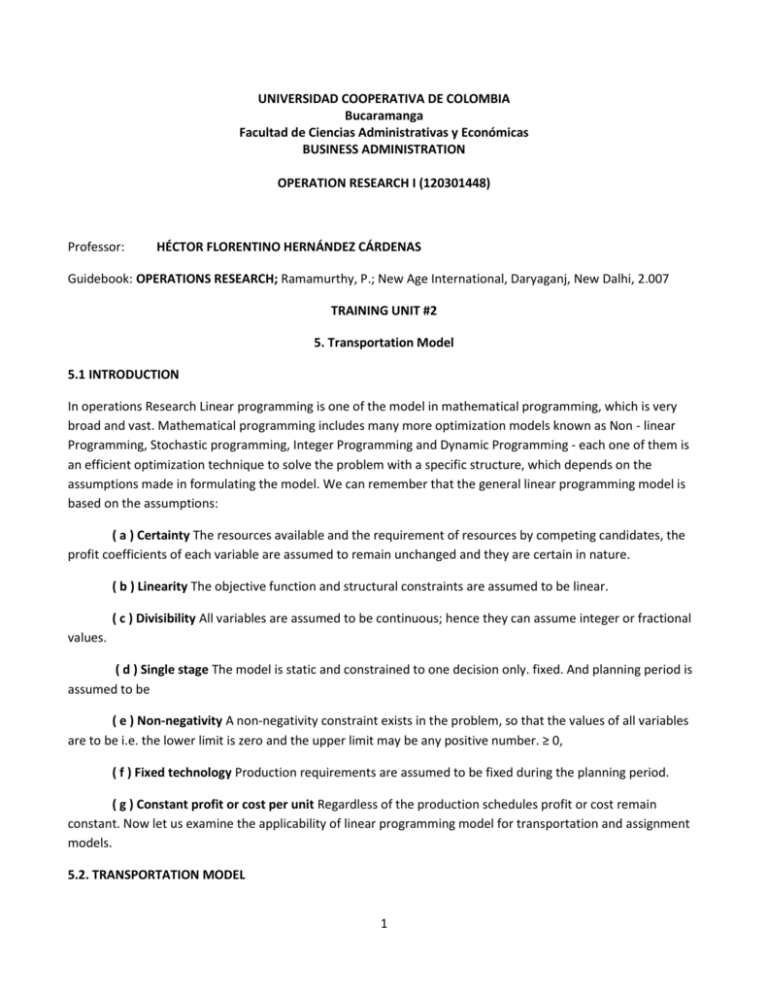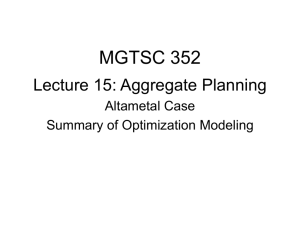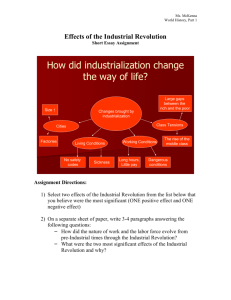
UNIVERSIDAD COOPERATIVA DE COLOMBIA
Bucaramanga
Facultad de Ciencias Administrativas y Económicas
BUSINESS ADMINISTRATION
OPERATION RESEARCH I (120301448)
Professor:
HÉCTOR FLORENTINO HERNÁNDEZ CÁRDENAS
Guidebook: OPERATIONS RESEARCH; Ramamurthy, P.; New Age International, Daryaganj, New Dalhi, 2.007
TRAINING UNIT #2
5. Transportation Model
5.1 INTRODUCTION
In operations Research Linear programming is one of the model in mathematical programming, which is very
broad and vast. Mathematical programming includes many more optimization models known as Non - linear
Programming, Stochastic programming, Integer Programming and Dynamic Programming - each one of them is
an efficient optimization technique to solve the problem with a specific structure, which depends on the
assumptions made in formulating the model. We can remember that the general linear programming model is
based on the assumptions:
( a ) Certainty The resources available and the requirement of resources by competing candidates, the
profit coefficients of each variable are assumed to remain unchanged and they are certain in nature.
( b ) Linearity The objective function and structural constraints are assumed to be linear.
( c ) Divisibility All variables are assumed to be continuous; hence they can assume integer or fractional
values.
( d ) Single stage The model is static and constrained to one decision only. fixed. And planning period is
assumed to be
( e ) Non-negativity A non-negativity constraint exists in the problem, so that the values of all variables
are to be i.e. the lower limit is zero and the upper limit may be any positive number. ≥ 0,
( f ) Fixed technology Production requirements are assumed to be fixed during the planning period.
( g ) Constant profit or cost per unit Regardless of the production schedules profit or cost remain
constant. Now let us examine the applicability of linear programming model for transportation and assignment
models.
5.2. TRANSPORTATION MODEL
1
The transportation model deals with a special class of linear programming problem in which the objective is to
transport a homogeneous commodity from various origins or factories to different destinations or markets at a
total minimum cost.
To understand the problem more clearly, let us take an example and discuss the rationale of transportation
problem. Three factories A, B and C manufactures sugar and are located in different regions. Factory A
manufactures, b 1 tons of sugar per year and B manufactures b tons of sugar per year and C manufactures b
tons of sugar. The sugar is required by four markets W, X, Y and Z. The requirement of the four markets is as
follows: Demand for sugar in Markets W, X, Yand Z is d , d , d and d tons respectively. The transportation cost of
one ton of sugar from each factory to market is given in the matrix below. The objective is to transport sugar
from factories to the markets at a minimum total transportation cost.
Factories
A
B
C
Demand in
tons
Availability in
tons
Transportation cost per ton in Rs
Markets
W
c 11
c 21
c 31
X
c 12
c 22
c 32
Y
c 13
c 23
c 33
Z
c 14
c 24
c 34
d1
d2
d3
d4
b1
b2
b3
∑𝑏 𝑗
∑𝑑 𝑗
For the data given above, the mathematical model will be:
Minimize Z = c 11 x 11 + c 12 x 12 + c 13 x 13 + c 14 x 14 + c 21 x 21 + c 22 x 22 + c 23 x 23 + c 24 x 24 + c 31 x 31 + c 32 x 32 +
c 33 x 33 + c 34 x 34 + c 41 x 41 + c 42 x 42 + c 43 x 43 + c 44 x 44 subject to a condition:
OBJECTIVE FUNCTION.
a 11 x 11 + a 12 x 12 + a 13 x 13 + a 14 x 14 ≤ b 1 (because the sum must be less than or equal to the available
capacity)
a 21 x 21 + a 22 x 22 + a 23 x 23 + a 24 x 24 ≤ b 2
a 31 x 31 + a 32 x 32 + a 33 x 33 + a 34 x 34 ≤ b 3
MIXED STRUCTURAL CONSTRAINTS.
(because the sum must be greater than or equal to the demand of the market. We cannot send less than what is
required)
a 11 x 11 + a 21 x 21 + a 31 x 31 ≥ d 1
a 12 x 12 + a 22 x 22 + a 32 x 32 ≥ d 2
a 13 x 13 + a 23 x 23 + a 33 x 33 ≥ d 3
a 14 x 14 + a 24 x 24 + a 34 x 34 ≥ d 4 and
All x ij and x ji are ≥ 0 Where i = 1,2,3 and j = 1,2,3,4. (This is because we cannot supply negative elements). NONNEGATIVITY CONSTRAINT.
2
The above problem has got the following properties:
1.
2.
3.
4.
It has an objective function.
It has structural constraints.
It has a non-negativity constraint.
The relationship between the variables and the constraints are linear.
We know very well that these are the properties of a linear programming problem. Hence the transportation
model is also a linear programming problem. But a special type of linear programming problem.
Once we say that the problem has got the characteristics of linear programming model, and then we can solve it
by simplex method. Hence we can solve the transportation problem by using the simplex method. As we see in
the above given transportation model, the structural constraints are of mixed type. That is some of them are of
≤ type and some of them are of ≥ type. When we start solving the transportation problem by simplex method, it
takes more time and laborious. Hence we use transportation algorithm or transportation method to solve the
problem. Before we discuss the transportation algorithm, let us see how a general model for transportation
problem appears. The general problem will have 'm' rows and 'n' columns i.e., m × n matrix.
Minimize Z =
∑ ∑ c ij x j s.t. where i = 1 to m and j = 1 to n
∑ a ij x ij ≤ b i where i = 1 to m and j = 1 to n
∑ a ij x ji ≥ d j where i = 1 to m and j = = 1 to n
5.3 COMPARISON BETWEEN TRANSPORTATION MODEL AND GENERAL LINEAR PROGRAMMING MODEL
Similarities
1.
2.
3.
4.
5.
Both have objective function.
Both have linear objective function.
Both have non - negativity constraints.
Both can be solved by simplex method. In transportation model it is laborious.
A general linear programming problem can be reduced to a transportation problem if (a) the a ij 's
(coefficients of the structural variables in the constraints) are restricted to the values 0 and/or 1 and (b)
There exists homogeneity of units among the constraints.
Differences
1. Transportation model is basically a minimization model; where as general linear programming model
may be of maximization type or minimization type.
2. The resources, for which, the structural constraints are built up is homogeneous in transportation
model; where as in general linear programming model they are different. That is one of the constraint
may relate to machine hours and next one may relate to man-hours etc. In transportation problem, all
the constraints are related to one particular resource or commodity, which is manufactured by the
factories and demanded by the market points.
3
3. The transportation problem is solved by transportation algorithm; where as the general linear
programming problem is solved by simplex method.
4. The values of structural coefficients (i.e. x ij ) are not restricted to any value in general linear
programming model, where as it is restricted to values either 0 or 1 in transportation problem. Say for
example:
Let one of the constraints in general linear programming model is: 2x –3y +10z ≤ 20. Here the
coefficients of structural variables x, y and z may negative numbers or positive numbers of zeros. Where
as in transportation model, say for example x 11 + x 12 + x 13 + x 14 = b i = 20. Suppose the value of
variables x 11 , and x 14 are 10 each, then 10 + 0. x 12 + 0. x 13 + 10 = 20. Hence the coefficients of x 11 and x
14 are 1 and that of x12 and x 13 are zero.
5.4 TRANSSHIPMENT PROBLEM
We may come across a certain situation, that a company (or companies) may be producing the product to their
capacity, but the demand arises to these products during certain period in the year or the demand may reach
the peak point in a certain period of the year. This is particularly true that products like Cool drinks, Textbooks,
Notebooks and Crackers, etc. The normal demand for such products will exist, throughout the year, but the
demand may reach peak points during certain months in the year. It may not possible for all the companies put
together to satisfy the demand during peak months. It is not possible to produce beyond the capacity of the
plant. Hence many companies have their regular production throughout the year, and after satisfying the
existing demand, they stock the excess production in a warehouse and satisfy the peak demand during the peak
period by releasing the stock from the warehouse. This is quite common in the business world. Only thing that
we have to observe the inventory carrying charges of the goods for the months for which it is stocked is to be
charged to the consumer. Take for example crackers; though their production cost is very much less, they are
sold at very high prices, because of inventory carrying charges. When a company stocks its goods in warehouse
and then sends the goods from warehouse to the market, the problem is known as Transshipment problem. Let
us work one problem and see the methodology of solving the Transshipment Problem. Problem. 4.11. A
company has three factories X, Y and Z producing product P and two warehouses to stock the goods and the
goods are to be sent to four market centers A, B, C and D when the demand arises. The figure given below
shows the cost of transportation from factories to warehouses and from warehouses to the market centers, the
capacities of the factories, and the demands of the market centers. Formulate a transportation matrix and solve
the problem for minimizing the total transportation cost.
5.5 Assignment Model
5.5.1 INTRODUCTION
In earlier discussion in chapter 3 and 4, we have dealt with two types of linear programming problems, i.e.
Resource allocation method and Transportation model. We have seen that though we can use simplex method
for solving transportation model, we go for transportation algorithm for simplicity. We have also discussed that
how a resource allocation model differ from transportation model and similarities between them. Now we have
another model comes under the class of linear programming model, which looks alike with transportation model
4
with an objective function of minimizing the time or cost of manufacturing the products by allocating one job to
one machine or one machine to one job or one destination to one origin or one origin to one destination only.
This type of problem is given the name ASSIGNMENT MODEL. Basically assignment model is a minimization
model. If we want to maximize the objective function, then there are two methods. One is to subtract all the
elements of the matrix from the highest element in the matrix or to multiply the entire matrix by –1 and
continue with the procedure. For solving the assignment problem we use Assignment technique or Hungarian
method or Flood's technique. All are one and the same. Above, it is mentioned that one origin is to be assigned
to one destination. This feature implies the existence of two specific characteristics in linear programming
problems, which when present, give rise to an assignment problem. The first one being the pay of matrix for a
given problem is a square matrix and the second is the optimum solution (or any solution with given constraints)
for the problem is such that there can be one and only one assignment in a given row or column of the given
payoff matrix. The transportation model is a special case of linear programming model (Resource allocation
model) and assignment problem is a special case of transportation model, therefore it is also a special case of
linear programming model. Hence it must have all the properties of linear programming model. That is it must
have: (i) an objective function, (ii) it must have structural constraints, (iii) It must have non-negativity constraint
and (iv) The relationship between variables and constraints must have linear relationship. In our future
discussion, we will see that the assignment problem has all the above properties.
5.5.2. The Problem
There are some types in assignment problem. They are:
(i)
(ii)
(iii)
(iv)
(v)
Assigning the jobs to machines when the problem has square matrix to minimize the time required
to complete the jobs. Here the number of rows i.e. jobs are equals to the number of machines i.e.
columns. The procedure of solving will be discussed in detail in this section.
The second type is maximization type of assignment problem. Here we have to assign certain jobs to
certain facilities to maximize the returns or maximise the effectiveness. This is also discussed in
problem number 5.2.
Assignment problem having non-square matrix. Here by adding a dummy row or dummy columns as
the case may be, we can convert a non-square matrix into a square matrix and proceed further to
solve the problem. This is done in problem number.5.9.
Assignment problem with restrictions. Here restrictions such as a job cannot be done on a certain
machine or a job cannot be allocated to a certain facility may be specified. In such cases, we should
neglect such cell or give a high penalty to that cell to avoid that cell to enter into the programme.
Traveling sales man problem (cyclic type). Here a salesman must tour certain cities starting from his
hometown and come back to his hometown after visiting all cities. This type of problem can be
solved by Assignment technique and is solved in problem 5.14.
Let us take that there are 4 jobs, W, X, Y and Z which are to be assigned to four machines, A, B, C and D. Here all
the jobs have got capacities to machine all the jobs. Say for example that the job W is to drill a half and inch hole
in a Wooden plank, Job X is to drill one inch hole in an Aluminum plate and Job Y is to drill half an inch hole in a
Steel plate and job Z is to drill half an inch hole in a Brass plate. The machine A is a Pillar type of drilling machine,
the machine B is Bench type of drilling machine, Machine C is radial drilling machine and machine D is an
5
automatic drilling machine. This gives an understanding that all machines can do all the jobs or all jobs can be
done on any machine. The cost or time of doing the job on a particular machine will differ from that of another
machine, because of overhead expenses and machining and tooling charges. The objective is to minimize the
time or cost of manufacturing all the jobs by allocating one job to one machine. Because of this character, i.e.
one to one allocation, the assignment matrix is always a square matrix. If it is not a square matrix, then the
problem is unbalanced. Balance the problem, by opening a dummy row or dummy column with its cost or time
coefficients as zero. Once the matrix is square, we can use assignment algorithm or Flood's technique or
Hungarian method to solve the problem.
5.6. COMPARISION BETWEEN TRANSPORTATION PROBLEM AND ASSIGNMENT PROBLEM
Now let us see what are the similarities and differences between Transportation problem and Assignment
Problem.
Similarities
1. Both are special types of linear programming problems.
2. Both have objective function, structural constraints, and non-negativity constraints. the relationship
between variables and constraints are linear.
3. The coefficients of variables in the solution will be either 1 or zero in both cases.
4. Both are basically minimization problems. For converting them into maximization problem same
procedure is used.
Differences
Transportation Problem
1. The problem may have rectangular matrix or
square matrix.
2.The rows and columns may have any number of
allocations depending on the rim conditions.
3.The basic feasible solution is obtained by
northwest corner method or matrix minimum
method or VAM
4.The optimality test is given by stepping stone
method or by MODI method.
5.The basic feasible solution must have m + n – 1
allocations.
6.The rim requirement may have any numbers
(positive numbers).
7.In transportation problem, the problem deals with
one commodity being moved from various origins to
various destinations.
Assignment Problem
1.The matrix of the problem must be a square matrix.
2.The rows and columns must have one to one
allocation. Because of this property, the matrix must be
a square matrix.
3.The basic feasible solution is obtained by Hungarian
method or Flood's technique or by Assignment
algorithm.
4.Optimality test is given by drawing minimum number
of horizontal and vertical lines to cover all the zeros in
the matrix.
5.Every column and row must have at least one zero.
And one machine is assigned to one job and vice versa.
6. The rim requirements are always 1 each for every row
and one each for every column.
7.Here row represents jobs or machines and columns
represents machines or jobs.
6
REFERENCES AVAILABLE IN ebrary
Sharma, Anand. Operations Research.
Mumbai, IND: Global Media, 2009. p 459.
http://site.ebrary.com/lib/ucooperativa/Doc?id=10415322&ppg=42
Copyright © 2009. Global Media. All rights reserved.
Ramamurthy, P.. Operations Research.
Daryaganj, Delhi, IND: New Age International, 2007. p 716.
http://site.ebrary.com/lib/ucooperativa/Doc?id=10367718&ppg=2
Copyright © 2007. New Age International. All rights reserved.
Mishra, D.N.; Agarwal, S.K.. Operation Research.
Lucknow, IND: Global Media, 2009. p 274.
http://site.ebrary.com/lib/ucooperativa/Doc?id=10416937&ppg=2
Copyright © 2009. Global Media. All rights reserved.
7





